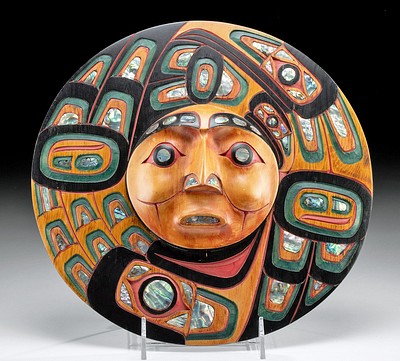Egyptian Faience Sons of Horus Amulets, ex MIA
Lot 27
About Seller
Artemis Gallery
686 S Taylor Ave, Ste 106
Louisville, CO 80027
United States
Selling antiquities, ancient and ethnographic art online since 1993, Artemis Gallery specializes in Classical Antiquities (Egyptian, Greek, Roman, Near Eastern), Asian, Pre-Columbian, African / Tribal / Oceanographic art. Our extensive inventory includes pottery, stone, metal, wood, glass and textil...Read more
Categories
Estimate:
$1,500 - $2,000
Absentee vs Live bid
Two ways to bid:
- Leave a max absentee bid and the platform will bid on your behalf up to your maximum bid during the live auction.
- Bid live during the auction and your bids will be submitted real-time to the auctioneer.
Bid Increments
| Price | Bid Increment |
|---|---|
| $0 | $25 |
| $300 | $50 |
| $1,000 | $100 |
| $2,000 | $250 |
| $5,000 | $500 |
| $10,000 | $1,000 |
| $20,000 | $2,500 |
| $50,000 | $5,000 |
| $100,000 | $10,000 |
| $200,000 | $20,000 |
About Auction
By Artemis Gallery
Dec 7, 2023
Set Reminder
2023-12-07 10:00:00
2023-12-07 10:00:00
America/New_York
Bidsquare
Bidsquare : Fine Antiquities, Ancient & Pre-Columbian Art
https://www.bidsquare.com/auctions/artemis-gallery/fine-antiquities-ancient-pre-columbian-art-14361
Classical antiquities, ancient, and ethnographic art from cultures encompassing the globe. Egyptian, Greek, Roman, Etruscan, Near Eastern, Asian, Pre-Columbian, Native American, African / Tribal, Oceanic, Spanish Colonial, Fine / Visual Arts, so much more! Artemis Gallery info@artemisgallery.com
Classical antiquities, ancient, and ethnographic art from cultures encompassing the globe. Egyptian, Greek, Roman, Etruscan, Near Eastern, Asian, Pre-Columbian, Native American, African / Tribal, Oceanic, Spanish Colonial, Fine / Visual Arts, so much more! Artemis Gallery info@artemisgallery.com
- Lot Description
Ancient Egypt, Late Dynastic to Ptolemaic Period, ca. 664 to 30 BCE. A pair of faience amulets depicting 2 of the 4 Sons of Horus, each holding a length of linen for the dead. The jackal-headed figure is Duamutef, guardian of the stomach who is protected by the goddess Neith, and the human-headed figure is Imsety, guardian of the liver who is protected by the goddess Isis. Each amulet was formed in a one-sided mold to compose their right-facing presentations, and each is similarly covered in lustrous blue glaze. Size of largest (Duamutef): 0.30" L x 0.61" W x 1.96" H (0.8 cm x 1.5 cm x 5 cm)
Exhibited at the Drexel Museum, Philadelphia, 1895 to 1914; with the Drexel Institute Collection, Minneapolis Museum of Art, 1915 to 1958, ref. nos. 16.329 and 16.330; at the Los Angeles County Museum of Art (LACMA) from 1986 to 1991; in the University of Arizona Museum of Art, October 1993 to December 1993; and in the Robert and Frances Fullerton Museum of Art (RAFFMA), California State University, San Bernardino from 1996 to 2023.
Provenance: Collection of Dr. W. Benson Harer, Los Angeles, California, USA; ex-Emil Brugsch Collection, curator of the Bulaq Museum, Cairo, Egypt; Exhibited at the Drexel Museum, Philadelphia, 1895 to 1914; with the Drexel Institute Collection, Minneapolis Institute of Art, 1915 to 1958, ref. nos. 16.329 and 16.330; at the Los Angeles County Museum of Art (LACMA) from 1986 to 1991; in the University of Arizona Museum of Art, October 1993 to December 1993; and in the Robert and Frances Fullerton Museum of Art (RAFFMA), California State University, San Bernardino from 1996 to 2023
All items legal to buy/sell under U.S. Statute covering cultural patrimony Code 2600, CHAPTER 14, and are guaranteed to be as described or your money back.
A Certificate of Authenticity will accompany all winning bids.
We ship worldwide and handle all shipping in-house for your convenience.
#182260Minor earthen deposits, otherwise intact and choice. Great preservation to finer details and blue glaze. Old museum number handwritten on verso of each piece.Condition
- Shipping Info
-
All shipping is handled in-house for your convenience. Your invoice from Artemis Gallery will include shipping calculation instructions. If in doubt, please inquire BEFORE bidding for estimated shipping costs for individual items.
-
- Buyer's Premium



 EUR
EUR CAD
CAD AUD
AUD GBP
GBP MXN
MXN HKD
HKD CNY
CNY MYR
MYR SEK
SEK SGD
SGD CHF
CHF THB
THB















